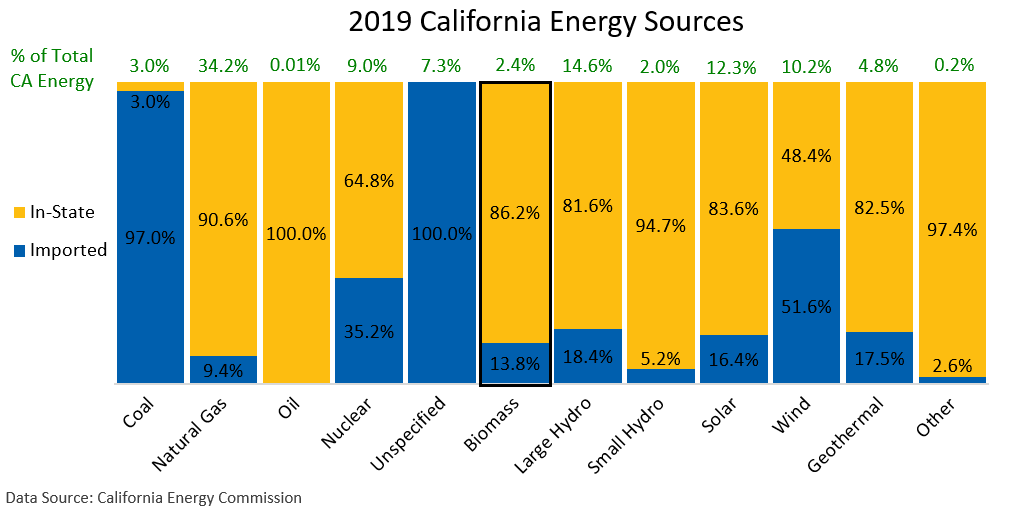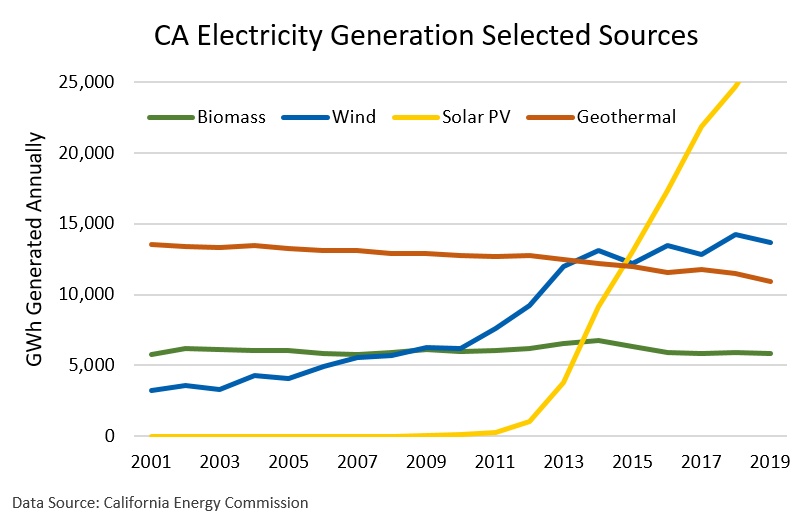Electricity Generation
The main use of biomass today is as a fuel for California's existing biomass power plants. There are around 25 operating biomass facilities which represent approximately 2.9 percent of the state's electrical generation capacity. Many larger plants sit idle while numerous smaller operations are in development. These biomass plants were primarily developed in the 1980s and use about five million bone dry tons (BDT) of biomass per year representing approximately 600 to 650 MW of capacity. They range from 5 to 60 MW in size. The existing power plants all use solid biomass fuel in the form of wood chips to heat water to raise steam which subsequently rotates a turbine and generator. Most power plants use stoker boilers although there are also some fluidized bed boilers.
Biomass Plant Types
Standalone: These facilities utilize biomass only and do not recirculate the heat. They have the lowest efficiency at around 25% but are the most common.
Cogeneration: This includes combined heat and power (CHP) facilities. Biomass is combusted to produce high-pressure steam that drives a turbine to create electricity. CHP or “co-gen” facilities use that spent steam after it exits the turbine for heating, drying, or other manufacturing processes, which can increase energy efficiency of the plant to 80%. A typical example would be a sawmill that uses the heat for drying lumber in kilns. CHP plants maximize the use of the heat energy from the wood fuel.
Co-Fire or Conversion: Fossil fuel facilities which have been converted to process biomass in addition to coal, natural gas, etc. Generally co-firing plants rely on direct combustion.
Find more about biomass processing methods on the Utilization Technology page.
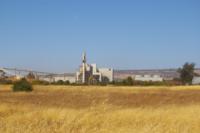
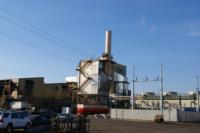
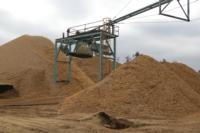
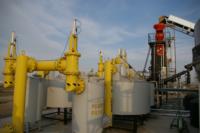
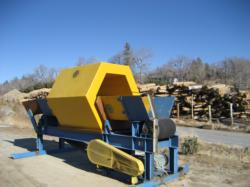
California Energy Production
The chart below shows the distribution of California’s energy sources. The majority of the state’s power comes from natural gas and hydroelectric, solar, wind, and nuclear sources. Much of this is generated in-state. As of 2019, biomass accounts for 2.44% of California’s energy usage and 2.92% of the energy generated in the state. Due to the massive acreage of forests with hazardous fuels loading throughout the state there is potential for this to be much higher. Overall there is a significant need for more infrastructure and incentives to cover the pre-processing and transport costs.
Despite having a developed biomass to electricity industry most of the biomass fuel does not come directly from the forest but is sourced, for example, from agricultural residues, urban woody waste, and sawmill residues. Forest sourced biomass is typically the most expensive fuel for the power plants and transportation is the limiting factor. The maximum viable haul from the forest to the biomass power plant is 50 miles to be financially feasible.
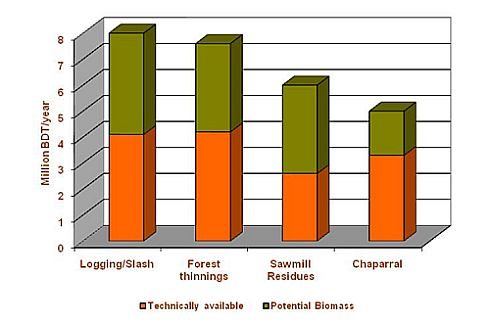
(Source: The California Biomass Collaborative Forum)
The above graph represents data for 2007 for forest derived sources of woody biomass. It shows the amount of biomass (in millions of bone dry tons per year) that was technically available for utilization, and the potential biomass which could be used but was not due to logistical difficulties such as difficult access and expense of removal. The graph shows that theoretically forests could provide much more of the fuel for biomass based electricity generation. Although this is from 2007, similar barriers persist today and the infrastructure has not significantly increased. Nearly 10 million bone dry tons of forest-based biomass could be made available on an annual sustainable basis, enough to double current electrical production.
The graph above shows biomass electricity generation within California over the past twenty years, as compared to power generated through wind, solar, and geothermal sources. Unlike solar and wind, biomass is not being taken full advantage of and allowed to grow to its potential. Both solar and wind have shown significant growth, particularly since around 2011, whereas biomass utilization has remained largely stagnant. This is not due to lack of fuels and feedstock available but rather due to lack of infrastructure and available funding for both facility development and processing/transport of forest biomass. Says Julee Malinowski Ball, executive director of the California Biomass Energy Alliance, “Electricity generated by biomass is costlier than other options such as solar and wind, a concern to state and public utilities commission officials who are responsible to ratepayers.” Biomass is more expensive than other renewable sources when only direct energy production costs are considered. However, utilizing biomass from appropriate sources saves taxpayers and communities massive amounts of money when the wildfire risk reduction that removing hazardous fuels creates is properly accounted for.
In April 2011 Governor Jerry Brown signed into law California's revised Renewable Portfolio Standard (RPS) that required 33% of the state's electricity to be generated through renewable sources (including biomass) by 2020. In 2018, SB 100 increased this RPS goal to 60% by 2030 and added the requirement that all electricity in the state be derived from carbon-free sources by 2045. Without increases in the prices that the investor owned utilities (IOUs) pay for biomass derived electricity it is unlikely that there will be significant investment in new plants. The grant opportunities pages have information on some of the current incentives available through the Forest Service for new facilities. The BioMAT and BioRAM programs implemented in 2012 and 2016 are also intended to incentivize IOU contracts and make biomass a more economically feasible option.
The recognized need to reduce wildland fire hazards combined with the reality of the commercial biomass power plant markets and the need for rural economic development has led to a renewed interest in smaller scale woody biomass utilization options that can be located closer to the fuel source. Of particular interest are systems that generate electricity by combusting synthesis gas from the gasification of biomass.
New designs in biomass combustion and gasification/combustion systems sized from 0.5 to 2 megawatts are available that can provide heat and electricity for manufacturing or a small community using from 5 to 40 tons of biomass per day (depending on system size and biomass moisture content). Systems smaller than 0.5 megawatt may also be appropriate for use in public buildings in remote areas where fuel and electricity costs are high. Currently these systems are relatively new or in development and therefore are costly and may have reliability issues. Smaller systems of this type may be eligible for various grants but have shown significant development time is required.
For further information on California's biomass power plants check out our biomass facilities map.

